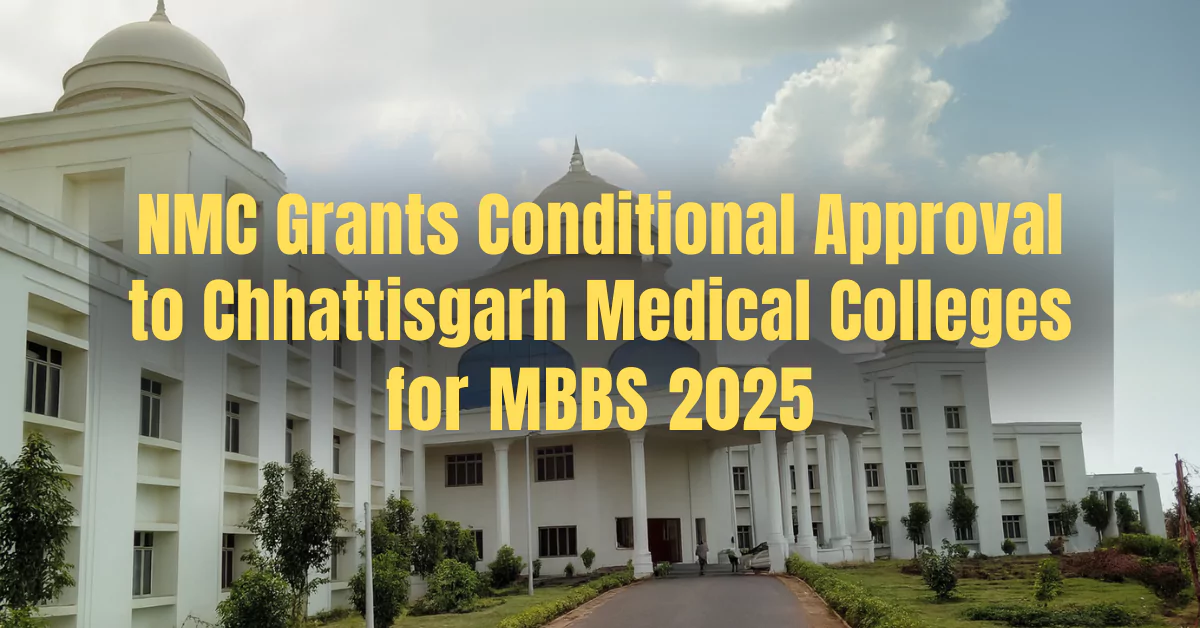The National Medical Commission (NMC) has given a conditional green signal to several government medical colleges in the state to continue MBBS admissions for the academic year 2025-26. But the approval comes with strict conditions.
According to a recent official release, the NMC’s Medical Assessment and Rating Board (MARB) has given permission to government medical colleges in Korba, Kanker, Mahasamund, Dantewada, and Janjgir-Champa to participate in MCC 2025 Counselling.
| The Medical Assessment and Rating Board (MARB) functions under the National Medical Commission (NMC) and is responsible for evaluating and approving medical colleges in India. It ensures institutions meet required standards in infrastructure, faculty, hospital facilities, and academic quality. |
All of these colleges had earlier faced serious scrutiny regarding infrastructure gaps, faculty shortages, and incomplete hospital facilities.
To fix the faculty shortages, there has been rforms in NMC’s Faculty Rule too. These colleges can take this opportunity to solve these problems.
But after a detailed evaluation and state-level assurance to fix the issues, the NMC has now granted a conditional go-ahead. This means students can be admitted for the MBBS batch of 2025-26, but the colleges must meet compliance criteria soon.
What Conditions Were Imposed?
The approval doesn’t come easily. The NMC has laid out clear terms and deadlines:
- Colleges must fill vacant faculty and non-teaching posts.
- Hospital infrastructure and patient care services need significant improvement.
- The hostel, labs, and teaching facilities must meet NMC’s minimum standards.
- Progress reports must be submitted to NMC within a specified timeline, or the recognition may be revoked next year.
Earlier this year, reports emerged that five new government medical colleges in Chhattisgarh were at risk of losing their MBBS seats for 2025-26 due to non-compliance with NMC norms. This raised panic among students preparing for NEET UG.
The state government swiftly intervened, submitting compliance affidavits and action plans promising rapid improvements.
Government Medical Colleges in Chhattisgarh (New District-wise Institutions)
| College Name | District | MBBS Seats |
|---|---|---|
| Government Medical College, Korba | Korba | 125 |
| Government Medical College, Kanker | Kanker | 125 |
| Government Medical College, Mahasamund | Mahasamund | 125 |
| Government Medical College, Dantewada (Dantewada GMC) | Dantewada (South Bastar) | 100 |
| Government Medical College, Janjgir-Champa | Janjgir-Champa | 100 |
Notes:
- These colleges are part of the state government’s medical expansion to improve healthcare access and education across the interior and tribal regions of Chhattisgarh.
- Admissions are through NEET UG counselling (state quota + AIQ as per norms).
- Each is affiliated with Pt. Deendayal Upadhyay Memorial Health Sciences and AYUSH University of Chhattisgarh, Raipur.
Few days back, NMC reversed its earlier decision and sanctions new medical college and 350 MBBS Seats in Gujarat. And also Jodgpur bench of Rajasthan High Court stayed NMC order and lifted ban on Geetanjali Medical College. Already this year MCC started NEET Counselling with less MBBS seats amid more competition.
Good News for NEET Aspirants
With the NMC’s green light, even if conditional, thousands of NEET UG aspirants from Chhattisgarh and nearby states can now parcicipate for more seats in NEET Counselling 2025. These colleges contribute significantly to increasing MBBS seat capacity in Chhattisgarh.
A health department official said, “We’ve already initiated recruitments and infrastructure upgrades. All efforts are being made to retain NMC recognition permanently.”


By this NMC is creating another mistakes.
One student having lower knowledge levels what is expressed through related percentile with specific cutoff 113 vs 144 this year, is having more capabilities of grasping what will be taught in the medical course syllabus.
The ridiculous system of equity and equality in education is spreading hatred and disharmony among the students.
Just think is it reasonable way of filling seats by who are unable to answer 20 percent of asked questions.
Let the lower cut-off be equal for all.
The minimum grasping power to understand next levels of education.
National thinkers should think better than few people like us.
While the concern about maintaining academic standards in medical education is valid, it’s important to understand that the NEET percentile system aims to balance both merit and social justice. The lower cutoff for SC/ST/OBC candidates does not imply that students from these categories lack the ability to grasp complex medical concept.
Rather, it acknowledges the disadvantages many of them face—like limited access to quality schooling, coaching, or resources—which impact their initial performance.
Medical education is rigorous, but once admitted, all students—irrespective of category—must meet the same academic requirements to progress and qualify as doctors. Admission through reservation is not a guarantee of graduation; consistent performance is essential.
Also, equity in opportunity is different from equality in measurement. If the playing field isn’t level, measuring everyone by the same yardstick may not be fair. Instead of generating division, the focus should be on strengthening support systems—like bridge courses, mentorship, and skill-building—for students from all backgrounds.
National policy should strive to ensure both academic competence and social inclusion. A balanced system can achieve this when implemented with accountability and fairness.
Why NMC is created one discrepancy by allowing students of SC,ST, OBC with 40 percentile but adherence to 50 percentile incase of Unreserved students, though reservation of seats for each category is fixed in seat matrix.
The NMC allows 40th percentile for SC/ST/OBC candidates to ensure fair representation and fill reserved seats, acknowledging systemic disadvantages. Despite fixed seat reservations, a uniform 50th percentile cutoff would leave many reserved seats vacant. This policy follows constitutional provisions for equity, not just equality.